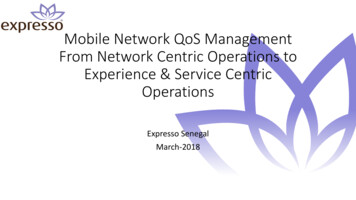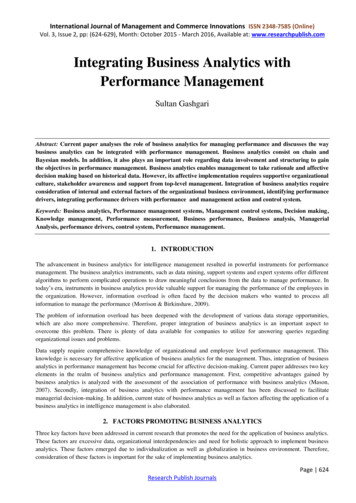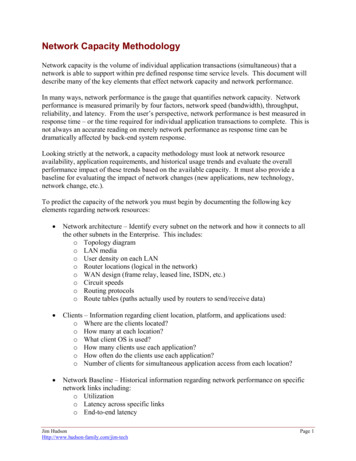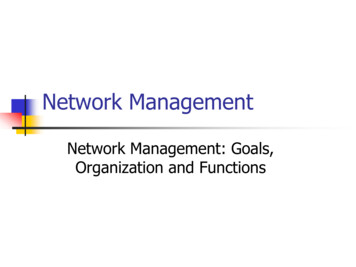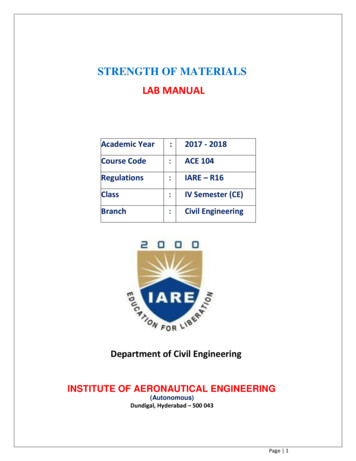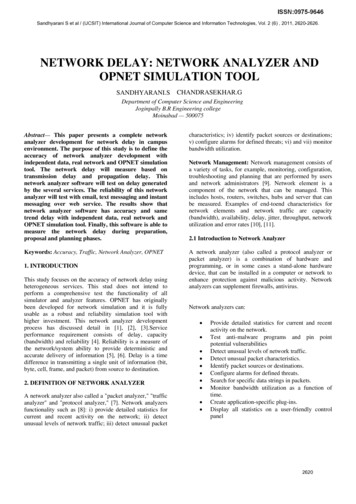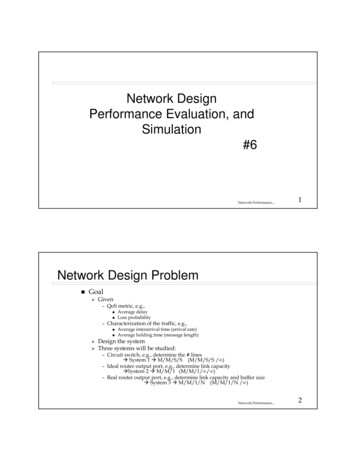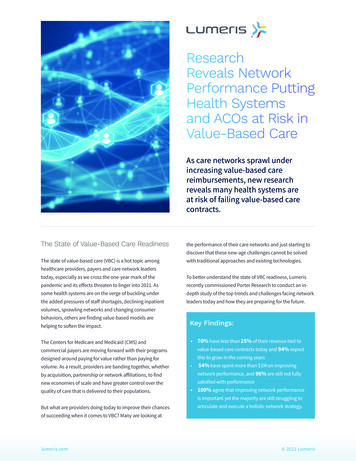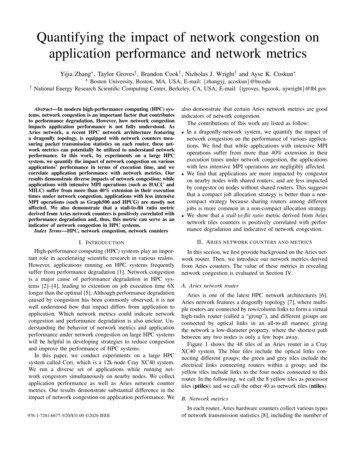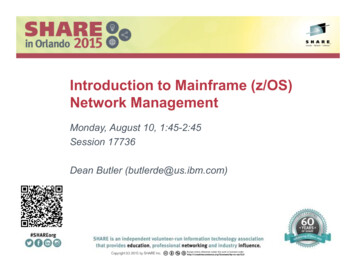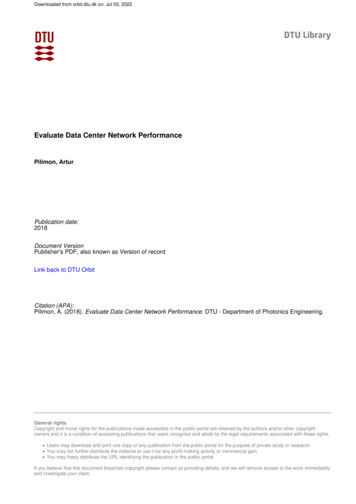
Transcription
Downloaded from orbit.dtu.dk on: Jul 03, 2022Evaluate Data Center Network PerformancePilimon, ArturPublication date:2018Document VersionPublisher's PDF, also known as Version of recordLink back to DTU OrbitCitation (APA):Pilimon, A. (2018). Evaluate Data Center Network Performance. DTU - Department of Photonics Engineering.General rightsCopyright and moral rights for the publications made accessible in the public portal are retained by the authors and/or other copyrightowners and it is a condition of accessing publications that users recognise and abide by the legal requirements associated with these rights. Users may download and print one copy of any publication from the public portal for the purpose of private study or research. You may not further distribute the material or use it for any profit-making activity or commercial gain You may freely distribute the URL identifying the publication in the public portalIf you believe that this document breaches copyright please contact us providing details, and we will remove access to the work immediatelyand investigate your claim.
Evaluate Data Center Network PerformanceData center network topology is crucial to latency in the network. Therefore,it is important to know the impact of new topologies before they are deployed.WHITE PAPERWHITE PAPER“A case study inhow to measureOVERVIEWData centers are the foundation for numerous services that many people today take forgranted. Use of these services grows exponentially, causing large organizations tocontinuously establish new, huge data centers to support the increasing demands.Data centers contain numerous servers connected through a data center network, whichis usually built with layer 2 switches and layer 3 routers. The topology of the data centernetwork is crucial for latency in the data communication to and from the data center andbetween servers in the data center.Tests can be conducted to measure latency and other performance parameters fordifferent data center network topologies. It is however important that tests can berepeated and reproduced to have comparable information from the tests.There are, of course, many topologies that can be used for data center networks. At DTUFotonik, Department of Photonics Engineering, scientists evaluate data center networktopologies with an SDN-based (Software-Defined Networking) control frameworkmeasuring network performance – primarily latency. This can be used to plan data centerscaling by testing how a new topology will function before changes are made.Data center network performance can, of course, be tested with Xena Networkssolutions. To generate test signals with stateful TCP traffic the Xena Networks testerssupporting layer 4-7 - XenaScale and XenaAppliance – are the obvious choice. Testing atlower layers is supported by the XenaBay and XenaCompact test chassis equipped withrelevant test modules.the latency of datacenter networktopologies with anSDN-based controlframework andXena testequipment”Xena Networks – Global Price/Performance Leaders in Gigabit Ethernet Testing – www.xenanetworks.comXena Networks – Global Price/Performance Leaders in Gigabit Ethernet Testing – www.xenanetworks.com1
ContentsOVERVIEW . 1INTRODUCTION . 3Data Center Network Testbeds: Performance Evaluation and Testing . 5Data Center Benchmarking . 7DTU Fotonik (Department of Photonics Engineering) . 9Xena Networks Data Center Test Solutions . 9Testing above Layer 3 . 9Testing up to Layer 3. 10Test Automation . 11CONCLUSION . 11WHITE PAPEREVALUATE DATA CENTER NETWORK PERFORMANCEXena Networks – Global Price/Performance Leaders in Gigabit Ethernet Testing – www.xenanetworks.comXena Networks – Global Price/Performance Leaders in Gigabit Ethernet Testing – www.xenanetworks.com2
There are thousands of data centers world-wide and they are indispensable for the modern, weboriented society. Data centers are fundamental for numerous cloud based services, which manypeople today take for granted like streaming, social media networking, e-commerce, on-linebanking, Anything-as-a-Service (XaaS) and many more. Large companies such as Google,Microsoft, Apple and Facebook run data centers to provide their offerings to customers and theycontinue to build new, hyperscale data centers to support exponentially growing demands.Data centers are built with numerous servers providing a service that is available to end-users (or“clients”). The servers are connected via a data center network, enabling communicationbetween the end users and the servers (“north-south” traffic). The data center network alsoenable communication between the servers inside the data center (“east-west” traffic).The data center networks are built with layer 2 switches and layer 3 routers. Early networks couldhave a hierarchical tree-like topology as depicted in figure 1.Figure 1: Early data center network topologyWith the simple topology in figure 1 there is a risk of congestion in the aggregation layer asseveral access switches share an aggregation switch. In addition, some of the “east-west” trafficwill experience increased latency when the server-to-server traffic must go through severalaggregation layer switches. Such issues will increase if more layers are added to support moreservers in the data center.Over the years, the simple data center network topology in figure 1 has developed into othertopologies, including the two-layer “leaf-spine” topology, having “leaf” switches forming anAccess layer and “spine” switches in the aggregation layer as illustrated in figure 2. With the leafspine topology every leaf switch is directly connected to all spine switches in a mesh. Hereby the“east-west” traffic only needs to go through one spine switch, minimizing the latency. The leaf-WHITE PAPERINTRODUCTIONXena Networks – Global Price/Performance Leaders in Gigabit Ethernet Testing – www.xenanetworks.comXena Networks – Global Price/Performance Leaders in Gigabit Ethernet Testing – www.xenanetworks.com3
Figure 2: Leaf-spine data center network topologyIn figure 1 and figure 2 layer 2 switches are used in the spine/aggregation layer. In someimplementations layer 3 routers are used instead. Furthermore, virtualization is widely spread indata centers, meaning that while the logical structure of the data center may be as shown infigures 1 and 2, the actual hardware components may look different.Software-Defined Networking (SDN) can also be used in data centers. SDN enables very flexibleand agile configurations, changing the behavior of network elements by updating their flowtables, which control the traffic forwarding. Hereby the traffic flow through the data centernetwork can dynamically and efficiently be adapted to changing requirements.Data centers are not isolated entities. In addition to communicating with end-users they can alsocommunicate together through optical Data Center Interconnect (DCI) links over the distance inbetween them. The increasing need for capacity on these links is driving the development of highspeed optical systems.Latency is an important parameter when designing data center networks. Some applications canbe extremely latency sensitive e.g. stock market trading and banking transactions. Therefore, tosupport latency sensitive applications, data centers network topologies should minimize latency.Tests can be executed to measure performance and, in particular, latency for different datacenter network topologies. It is, however, important that tests can be repeated and reproducedin order to have comparable information from the tests.WHITE PAPERspine topology can include spine switches that only handle the “east-west” traffic, reducing therisk for congestion. The leaf-spine topology is useful for data centers with more “east-west”traffic than “north-south” traffic.Xena Networks – Global Price/Performance Leaders in Gigabit Ethernet Testing – www.xenanetworks.comXena Networks – Global Price/Performance Leaders in Gigabit Ethernet Testing – www.xenanetworks.com4
DATA CENTER NETWORK TESTBEDS: PERFORMANCE EVALUATIONAND TESTINGData centers (DC) and their supporting network infrastructure have become a backbone of theglobal digital economy, which needs to provide reliable and scalable communication services,while continuously being challenged in terms of the energy efficiency and resource utilization,Quality of Service (QoS) and performance isolation, architectural scalability and costeffectiveness. Hence, it is of paramount importance to conduct timely and comprehensive testingand performance evaluation of the existing and new technologies and protocols, networkarchitectures and traffic engineering (TE) approaches. In addition to analytical modelling andsimulations, this can be achieved by applying diverse and innovative research methodologies fortesting of real data center network equipment in a realistic communication context (e.g.,generating DC-specific traffic profiles, conducting experiments on large-scale DC networktestbeds) so that the obtained results could be applicable at scale.Building a large-scale data center just for experimental research purposes may not be a feasibleoption, both from the footprint and financial point of view. However, assembling a smaller scale,but sufficiently functional data center testbed, consisting of a subset of real data center networkequipment (e.g., electrical and optical switches) with powerful SDN-based control framework andhigh-performance traffic generators with useful stress-testing capabilities, is a more realistic andflexible approach.DTU Fotonik – Department of Photonics Engineering at the Technical University of Denmark – isactively using the capabilities of the Layer 2-3 (Xena Bay) and Layer 4-7 (Xena Scale) networktesters for their data center research. One of the recent studies carried out was focusing on theexperimental evaluation of a direct-connection topology, namely a Hypercube structure, appliedas a data center network interconnect, enhanced with optical bypass switching capabilities. Highlevel network connectivity diagrams of two configuration scenarios of a data center testbed arepresented in figure 3 (8-node Cube) and figure 4 (16-Hypercube), respectively. All the data centernetwork switches, both optical and electrical, are configured and controlled via an external SDNcontroller. Nevertheless, one of the most challenging tasks faced in this research activity was tocreate a functional data center-oriented traffic generation framework to be able to carry outdifferent conformance and performance tests. After multiple different approaches have beentried out, the solution was found by combining the functional capabilities of both Layer 2-3 andLayer 4-7 testers. The reasons are outlined as follows:1.We were looking for a solution, which could help us achieve two main goals: a) to be able toperform high-speed stress-testing of particular data center network segments and devices byloading these components with large number of traffic flows with sustainable data rates, andWHITE PAPERThere are of course more topologies that can be used for data center networks. At DTU Fotonik,Department of Photonics Engineering scientists evaluate data center network topologies with anSDN-based (Software Defined Networking) control framework and measure the performance –primarily latency. This can be used to plan data center scaling by testing the impact of a newtopology before changes are made in the data center network.Xena Networks – Global Price/Performance Leaders in Gigabit Ethernet Testing – www.xenanetworks.comXena Networks – Global Price/Performance Leaders in Gigabit Ethernet Testing – www.xenanetworks.com5
2.When conducting network testing at scale, test automation capabilities are becomingcritically important, because this results in significant time savings to define and configurevarious test scenarios as well as process and analyze the gathered results. We used theavailable CLI-based scripting interface and developed Python scripts to control the tests,gather statistics and visualize the results. Thus, by just changing a set of command-linearguments, a completely different set of tests can be configured automatically. This aspectgreatly extends the possibilities of test repeatability and reproducibility of the results.Xena L2-3Traffic GeneratorXena L2-3Traffic GeneratorLegendPolatisToR switchOptical highcapacity linksFast Optical shortcut pathSlow ToR-only pathPolatis Optical Circuit SwitchControl planeSDN controllerFigure 3: DCN Testbed setup. 8-node Cube with Optical bypass and Xena Bay L2-3 testerXena L2-3Traffic GeneratorLegendToR switchOptical highcapacity linksFast Optical shortcut pathSlow ToR-only pathPolatis Optical Circuit SwitchXena L2-3Traffic GeneratorWHITE PAPERb) to be able to create customized traffic profiles with traffic flow groups of differentduration, data volume size as well as configurable network, transport and application layerproperties. The former objective was achieved by using Layer 2-3 Xena Bay platform, whichalso provides great means of collecting accurate per-stream performance statistics (e.g.,average, maximum, minimum latency and jitter, packet loss, etc.). The latter requirementwas satisfied by using Layer 4-7 Xena Scale tester, which allowed us to mix different groupsof stateful (TCP connections) and stateless (UDP flows) traffic flows and configure relevantparameters, such as TCP window sizes, congestion control, segment or flow sizes.Figure 4: DCN Testbed setup. 16-Hypercube with Optical bypass and Xena Bay L2-3 testerXena Networks – Global Price/Performance Leaders in Gigabit Ethernet Testing – www.xenanetworks.comXena Networks – Global Price/Performance Leaders in Gigabit Ethernet Testing – www.xenanetworks.com6
E2E Aggr. Max latency1s Avg. Jitter14.65016.0014.0014.0014.58413.00 4.47210.0014.4508.0014.40014.3926.0014.350Jitter, ns14.600End-to-End latency (µs)14.004.004.0014.30014.25014.28714.226 2914.22814.2000.00102030405060708090100110Traffic load (% of 10 Gbps link)Figure 5: End-to-End latency measurement test results obtained with Xena Bay L2-3tester. Topology: 8-node Cube, Polatis OCS. Legend: E2E – End-to-End, Aggr. –Aggregate, Avg. – Average, s – second, Max – Maximum3.Another important aspect in favor of using an advanced hardware traffic generator andtester, instead of a software traffic generator, is the resolution (granularity) and accuracy ofthe measurement results. Considering latency measurements in the context of data centernetworking, this becomes particularly problematic when using software generators, sincethe crafted packets are reaching the Network Interface Card (NIC) through the shared kernelspace of the underlying operating system (OS), and time-expensive interrupt-basedprocessing is greatly limiting the maximum achievable packet generation rate. Software-leveltimestamping accuracy is another issue, since simple software generators are limited by theclock granularity of the underlying OS, while hardware counterparts, such as Xena testers,offer more accurate hardware timestamping capabilities and allow tracking statistics atdifferent level of detail, e.g., as it can be seen in figure 5.DATA CENTER BENCHMARKINGFollowing the massive deployment of data centers, the Internet Engineering Task Force (IETF) inAugust 2017 published a couple of documents on data center benchmarking: RFC 8238 Data Center Benchmarking Terminology RFC 8239 Data Center Benchmarking MethodologyWHITE PAPERE2E Aggr. Avg. latencyXena Networks – Global Price/Performance Leaders in Gigabit Ethernet Testing – www.xenanetworks.comXena Networks – Global Price/Performance Leaders in Gigabit Ethernet Testing – www.xenanetworks.com7
Data center traffic dynamically changes over time. The traffic will in periods predominantly be“north-south” between the servers and a client outside the data center and in other periods bemore ”east-west” oriented between servers in the data center. Traffic can be a mix of TCP andUDP flows, and can be a result of point-to-multipoint or multipoint-to-multipoint communicationpatterns, commonly found in data centers. Traffic may be sensitive to latency or throughput andall kinds of traffic can exist simultaneously in a data center network element. Previously IETF haspublished several documents on network element and network benchmarking, including: RFC 2544 Benchmarking Methodology for Network Interconnect Devices RFC 2889 Benchmarking Methodology for LAN Switching Devices RFC 3918 Methodology for IP Multicast BenchmarkingRFC 8239 have test cases based on the above RFCs. In addition, it includes test cases that betterthan the above RFCs represent the wide range of traffic conditions that can exist in a data center.RFC 8239 test cases include:TestDescriptionLine-Rate TestingA "maximum rate" tests for the performance values for throughput,packet drop, latency and jitter. Tests are conducted as a port-pair test andas a full-mesh testBuffering TestingMeasuring the DUT buffer size under various traffic conditionsMicroburstTestingIdentify the maximum amount of packet bursts that a DUT can sustainunder various configurationsHead-of-LineExamine a DUT’s behavior in case of HOLB and measure packet lossBlocking (HOLB)caused by HOLB, which occurs when packets are held up by the firstpacket ahead waiting to be transmitted to a different output portIncast Stateful and Measure TCP Goodput (retransmissions excluded) and latency underStateless Trafficvarious traffic conditions. The test simulates a mix of stateful (TCP) flowsrequiring high goodput and stateless (UDP) flows requiring low latencyTable 1: RFC 8239 testsThe RFC 8239 tests require that several (in some cases all) ports of the DUT are connected to atraffic generator, as illustrated in figure 6.WHITE PAPERAs the titles indicate, RFC 8238 presents new terminology in relation to benchmarking of datacenter network equipment, while RFC 8239 defines how to perform the benchmarking tests ofswitches and routers that are used in a data center.Xena Networks – Global Price/Performance Leaders in Gigabit Ethernet Testing – www.xenanetworks.comXena Networks – Global Price/Performance Leaders in Gigabit Ethernet Testing – www.xenanetworks.com8
DTU FOTONIK (DEPARTMENT OF PHOTONICS ENGINEERING)At DTU Fotonik, researchers work with multiple aspects of light (photons), in every layer werelight can be used and controlled. Approximately 220 researchers work at DTU Fotonik, includingaround 90 PhD students. Taught programs are B.Sc. Network Technology and IT, M.Sc. inTelecommunications and M.Sc. in Photonics Engineering. In the Network Technologies andService Platforms group at DTU Fotonik, the research is focused on four main directions, such asdata centers (including SDN), fronthaul/backhaul solutions for mobile networks, IoT and corenetworks. In particular, the group has been leading the recently completed EU FP7 projectCOSIGN: Combining Optics and SDN In next Generation datacenter Networks (2014 – 2017). Thegroup has sophisticated lab facilities to carry out a variety of datacenter network experiments.XENA NETWORKS DATA CENTER TEST SOLUTIONSData Center Network Performance can of course be tested with Xena Networks test solutions. Togenerate test signals with stateful TCP traffic the Xena Networks testers supporting layer 4-7 XenaScale and XenaAppliance – are the obvious choice. Testing at lower layers is supported bythe XenaBay and XenaCompact test chassis equipped with relevant test modules.TESTING ABOVE LAYER 3Figure 7: The powerful Xena Networks Layer 4-7 testers XenaScale and XenaApplianceWHITE PAPERFigure 6: Typical RFC 8239 test setupXena Networks – Global Price/Performance Leaders in Gigabit Ethernet Testing – www.xenanetworks.comXena Networks – Global Price/Performance Leaders in Gigabit Ethernet Testing – www.xenanetworks.com9
Wire-speed stateful TCP traffic generation and analysis with extreme performance TLS performance testing with different cipher suites and certificates Application emulation with real-world application traffic mixes enabled by XenaAppMix Replay captured traffic at scale Configuration and tuning of Ethernet, IP and TCP header fields for advanced traffic scenarios Stateful TCP connection HTTP get/put/head/post Extensive live stats and test reports 1G – 10G Ethernet interfaces 40G Ethernet interfaces (XenaScale) High port density – up to 12 x 10 GigE (XenaScale) Configurable allocation of processing resources to Ethernet test ports Wire-speed traffic capture Switched and routed network topologies, NAT support Export packet capture to industry standard pcap/WiresharkTESTING UP TO LAYER 3Figure 8: The versatile and powerful Xena Networks Layer 2-3 testers XenaBay andXenaCompactTesting at lower layers is supported by the XenaBay and XenaCompact test chassis equipped withrelevant test modules, which can support data rates up to 100 Gbps. Up to 12 test modules canbe installed in the XenaBay chassis. Based on Xena’s advanced architecture, XenaBay andXenaCompact equipped with relevant test modules are proven solutions for Ethernet testing atlayers 2 and 3. Advanced test scenarios can be performed using the free Xena test applications:WHITE PAPERXena Network’s XenaScale and XenaAppliance can be used to generate TCP, HTTP/TCP and UDPtraffic streams simultaneously. In addition, both products offer stateful end-to-end testing ofnetwork appliances such as switches, firewalls, routers, NAT routers, proxies, load-balancers,bandwidth shapers and more. The platform is also suitable to characterize entire networkinfrastructure performance for TCP. Top features include:Xena Networks – Global Price/Performance Leaders in Gigabit Ethernet Testing – www.xenanetworks.comXena Networks – Global Price/Performance Leaders in Gigabit Ethernet Testing – www.xenanetworks.com10
XenaManager-2G test software is used to configure and generate streams of Ethernet trafficbetween Xena test equipment and Devices Under Test (DUTs) and analyze the results Xena2544 offers full support for the 4 test types specified in RFC 2544: Throughput, Latency,Frame loss and Back-to-back frames; Jitter (Frame Delay Variation) is also supported Xena1564 provides full support for both the configuration and performance test typesdescribed in Y.1564 for complete validation of Ethernet Service Level Agreements (SLAs) in asingle test Xena2889 is an application for benchmarking the performance of Layer 2 LAN switches inaccordance with RFC 2889 Xena3918 makes it easy to create, edit and execute all test types specified in RFC 3918. RFC3918 describes tests for measuring and reporting the throughput, forwarding, latency andIGMP group membership characteristics of devices that support IP multicast protocolsTEST AUTOMATIONThe Xena Networks L4-7 and L2-3 test solutions have a scripting Command Line Interface (CLI),which is ideal for test automation. The user can create a script, which defines a test sequencethat can be repeated as often as required, providing reproduceable results.CONCLUSIONData centers contain numerous servers providing a service for end-users. The servers areconnected via a data center network, which is built with layer 2 switches and layer 3 routers. Thetopology of the data center network is crucial for latency in the communication between serversand end users and in server-to-server communication.Many topologies can be used for data center networks. At DTU Fotonik, Department of PhotonicsEngineering scientists evaluate the performance of different data center network topologies withan SDN-based (Software Defined Networking) control framework, measuring primarily latency.This can be used to plan data centerscaling by testing how a new topologywill function before changes are made.Data Center Network performance can of course betested with Xena Networks test solutions. Togenerate test signals with stateful TCP traffic theXena Networks testers supporting layer 4-7 XenaScale and XenaAppliance – are the obviouschoice. Testing at lower layers is supported by theXenaBay and XenaCompact test chassis equippedwith relevant test modules.WHITE PAPER Xena Networks – Global Price/Performance Leaders in Gigabit Ethernet Testing – www.xenanetworks.comXena Networks – Global Price/Performance Leaders in Gigabit Ethernet Testing – www.xenanetworks.com11
measuring network performance - primarily latency. This can be used to plan data center scaling by testing how a new topology will function before changes are made. Data center network performance can, of course, be tested with Xena Networks solutions. To generate test signals with stateful TCP traffic the Xena Networks testers
